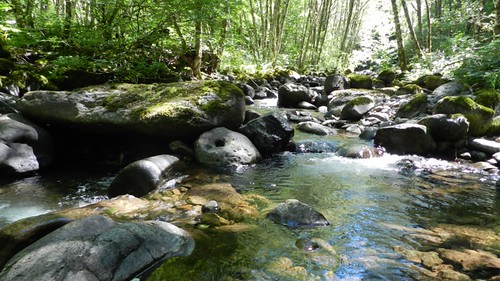Clean Water Act’s Next Role Could Play Out On NW Logging Roads
MOLALLA, Ore. — Mark Schmidt remembers fishing as a kid for steelhead on the Molalla River.
He also remembers how rain could ruin a day on the river.
“If we could so much as hear the raindrops on the shingles in the night, we were aware that we would not be fishing in the morning,” Schmidt recalls.

That rain sent dirt pouring from logging operations into the river. It made the water look like orange, wet cement. It often made the river unfishable for Schmidt – and downright unhealthy for the salmon and steelhead themselves.
That was in the 1960s. Today, the federal Clean Water Act and state forest practices laws require landowners and loggers to follow standards, called Best Management Practices, to protect the quality of myriad streams and rivers that flow through forests.
But some clean water advocates are calling for tighter regulation of one type of logging-caused pollution: muddy runoff from forest roads.
The U.S. Supreme Court will rule in the coming year on the question of exactly how the Clean Water Act applies to the hundreds of thousands of miles of logging and forest roads.
Forest roads are a major source of fine sediment pollution, says Dave Powers, Environmental Protection Agency’s Forest and Rangeland Manager in the Northwest.
“Roads can frequently contribute up to 90 percent of the sediment going into streams, particularly if they’re not properly designed, located and operated,” Powers says.
Roads alter the natural plumbing of a forest. Their hard, flat surfaces collect and channel rainwater. During storms that fast-moving water can carry fine sediment into streams. Plugged culverts and unstable road fill can trigger landslides.
Powers says erosion and other processes naturally move sediment into streams — often a mix of gravel, boulders, and smaller material. However, roads can deliver unhealthy and unnatural amounts of mud and fine sediment, causing problems for salmon and trout:
“It can prevent spawning from taking place, it can smother eggs. They need cool water, clean water, and they need oxygen in it. And sediment isn’t conducive to any of those things.”
Sediment from forest roads has contributed to flooding problems on the Skokomish River in Washington, impaired habitat for trout in the Idaho panhandle, and might be contributing to muddy drinking water in coastal Oregon communities (DEQ report available here).

Mount Hood National Forest road map. Each of the Northwest’s 24
national forests contains thousands of miles of logging roads.
Credit: USFS
Keeping roads and streams separated solves the problem, Powers says. Most roads collect stormwater in ditches; if those ditches empty into streams, they muddy the water.
The fix: drain muddy storm water onto the forest floor instead. The forest floor acts like a sponge, slowing the water down and letting the sediment filter out.
Recent monitoring in Washington shows that roughly one in 10 logging roads in the state drain runoff into a stream.
Oregon doesn’t have recent data on forest roads, but a 2002 report to the Department of Forestry shows that at least one in four forest roads in the state drain into a stream.
Oregon, Washington, and Idaho each have lengthy state forest practice rules. They detail where and how new forest roads should be built. They call for cross drains and ditches that empty on the forest floor — to protect streams from sediment.
But there are lots of logging roads in the Northwest that were built before those standards were in place. Upgrades can get expensive, Powers says.
The U.S. Forest Service, for example, manages about 91,000 miles of roads in Washington and Oregon. It estimates a cost of $1.1 billion to bring them up to standard to protect water quality.
Washington state is requiring large private forest landowners to inventory all their roads and to bring them up to code by 2021. In contrast, Oregon has a voluntary program that encourages landowners to upgrade older forest roads.
Mark Riskedahl, an attorney with the Northwest Environmental Defense Center, says that for decades, an EPA rule has given logging roads an exemption from the permitting process that regulates most types of water pollution, including stormwater runoff that flows through pipes into streams.
“Scrapyards, gravel mines, airports, municipalities have to get these permits for discharges from road networks in cities large and small,” Riskedahl says.
In 2006, the NEDC filed a lawsuit to force the EPA to require permits for logging roads:
“Why should, you know, Wall Street timber investment firms and huge timber companies get special treatment under the Clean Water Act? If they’re generating pollution, they should be held accountable just as everybody else is.”
The NEDC won the case before the 9th Circuit Court of Appeals, but the U.S. Supreme Court is hearing an appeal.
Congress and even the EPA oppose the idea of permits for logging road sediment.
Timber industry representatives say a permitting program would create unnecessary paperwork and bureaucracy and won’t do more to protect water quality than Best Management Practices, or BMPs, required by the states.
On the Molalla River, at least, there is evidence that the BMPs are doing their job, keeping the water clean.
Jeff Mehlschau is an engineer for Weyerhaeuser’s Clackamas Tree farm in the Molalla basin.
On a tour of the property, he points out dozens of new culverts, cross drains, reconstructed bridges, and a place where the North Fork Molalla road runs into a cascading stream.
The cross drain should force muddy runoff to make a right-hand turn before it hits the creek.“We do have a live stream behind us. And right up here is our cross drain, ” he says.
“And we get it off onto the forest floor and let it infiltrate.”
Weyerhaeuser’s Roads, By the Numbers
- 200,000 miles of road
- 54,000 stream crossings
- 175,000 cross drains
- $7 to $12 million spent annually on upgrades
Mehlschau says his roads are all up to code and not polluting streams with muddy runoff.
Weyerhaeuser has been criticized in other parts of the Northwest, notably the Chehalis basin, for logging practices that contribute to erosion and sediment delivery.
In Molalla, the company’s neighbors say it has been effective in protecting water quality.

The north fork Molalla river flows through Weyerhaeuser land. Local water advocates say past logging practices scoured the riverbed, but today the water is cool and clear.
Mark Schmidt, who used to fish the Molalla as a kid, now helps run the Molalla River Alliance, a conservation group. He credits Weyerhaeuser with upgrading its roads, making it easier for fish to pass through culverts and keeping sediment out of the river. And he thinks Oregon’s Forest Practices Act has been effective here.
He says the Molalla occasionally gets murky for a day or two. Otherwise, the water is clear.
“We don’t have anywhere near the turbidity in the river that we did in the 1960s,” he says. “I mean, there’s just no comparison.”
Sediment And Turbidity In The Northwest: An Interactive Map.
View Sediment Pollution In the Northwest in a larger map
The story you just read is only possible because readers like you support our mission to uncover truths that matter. If you value this reporting, help us continue producing high-impact investigations that drive real-world change. Your donation today ensures we can keep asking tough questions and bringing critical issues to light. Join us — because fearless, independent journalism depends on you!
— Jacob H. Fries, executive director
DonateCancel anytime.











